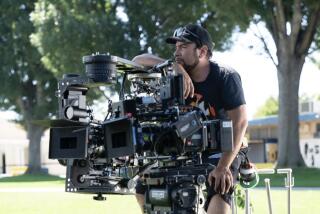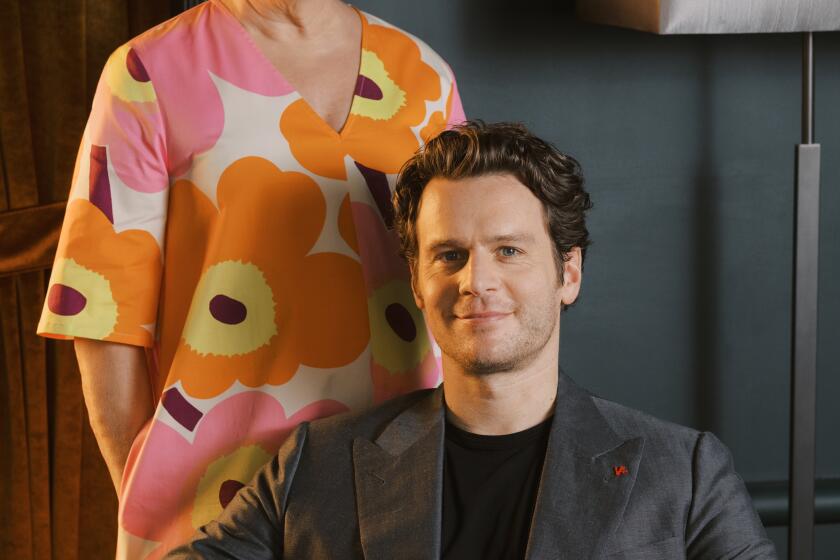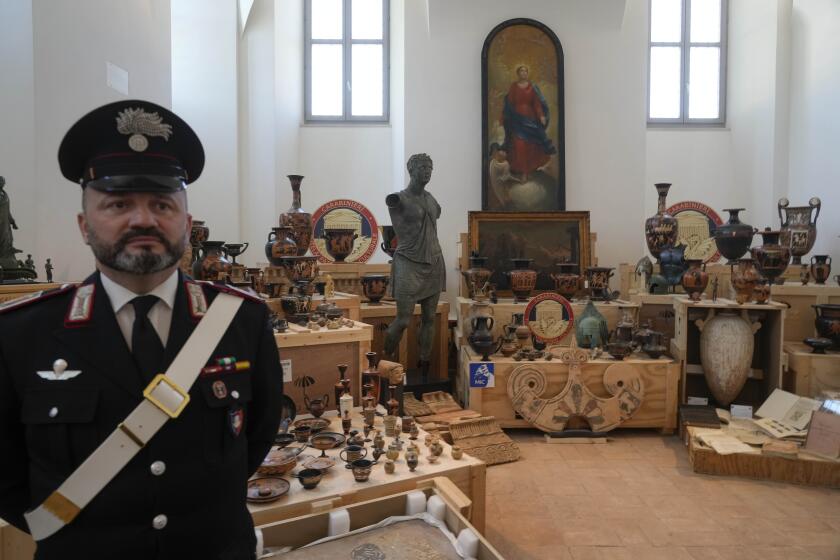AROUND THE GALLERIES
Jean Lowe’s paintings of Bavarian palaces made over into big-box discount outlets are as reasonable and believable as they are preposterous. Their wicked mixture of giddy hilarity and deadly sobriety puts them in tune with our times, when things are not what they seem and topsy-turvy absurdity seems to have replaced levelheaded stability as society’s modus operandi.
From the moment you step into the Rosamund Felsen Gallery, it’s clear that you’re in a familiar world, a banal and terrifying place filled with Costcos and Wal-Marts as well as more ostentatious displays of wealth. But something is out of whack.
Titled “Love for Sale,” the show’s 10 small collages, 12 big paintings and 56 prop-style books (on two papier-mache shelves) put visitors in mind of a future even stranger than the present. Think Vegas’ flashiest casinos retrofitted as factory-second stores. Or Soviet-era chateaux that have fallen on hard times and are forced to sell overstocked leftovers.
In the entryway, a series of page-size collages packs the lavish interiors of baroque castles with aisle upon aisle of discount consumer goods. Polyester slacks and gallon bottles of bleach jostle for your attention among stacks of trash bins, towers of light beer, piles of plastic floor mats and super-sized packages of candy. In the background, marble columns, crystal chandeliers and mural-scale paintings of aristocrats, angels and gods kick the onslaught of visual stimulation into high gear.
Lowe has cut and pasted together her point-and-shoot pictures with none of the sleek seamlessness of digitally manipulated imagery. Jarring shifts exist between one snapshot and another. This recalls the disruptive incoherence of early 20th century Cubism and the head-spinning pace of Italian Futurism. It also harks back to David Hockney’s kaleidoscopic photo-collages from the 1980s, although with more Dr. Frankenstein-style fragmentation and punk chaos.
The photos in Lowe’s collages were made in stores in Southern California and on a summer trip to southern Germany’s most popular castles. They serve as highly detailed studies for the stunning enamels on canvas that fill three adjoining galleries and spill into an office.
Lowe’s paintings are even stranger than her collages. Many measure up to 8 feet long and 6 or 7 feet high. All smooth over the visual turbulence of the collages, creating spaces that induce wooziness.
Labyrinthine passages weave their way between cheap shelves and wood palettes, all stacked with bargain-priced items that are neither glamorous nor extravagant. The ceilings, walls and balustrade-festooned balconies do not follow the rules of perspective but undulate freely, as if under the influence of powerful hallucinogens or buckets of booze. Terra firma seems unstable.
Lowe’s casual paint handling causes the consumer goods she depicts to look better than they do in life. It also makes the Baroque paintings and ceiling murals look worse. This compromise between high art and low culture suggests that splitting the difference between extremes creates a mutation both queasy and questionable.
The titles of the thick, papier-mache tomes on Lowe’s pair of bookshelves chart the absurdities of a world turned on its ear. “Regulating Empathy,” “Who’s Who in American Prisons,” “Contemporary Genocide in Perspective,” “The Low-Impact Freak-Out,” “Hooked on Addiction Memoirs,” “Torture Preparedness,” “Foreclosure Etiquette” and “What Would Satan Eat?” make rationality and its opposite into comic co-conspirators whose antics are tacky, true and tuned into the present.
--
Rosamund Felsen Gallery, 2525 Michigan Ave., Santa Monica, (310) 828-8488, through May 16. Closed Sundays and Mondays. www.rosa mundfelsen.com
--
Regularly doing the impossible
Over the last 25 years, Jim Isermann has shown himself to be a one-man factory and an impressively productive, phenomenally adaptive one at that.
Patiently churning out one-of-a-kind rugs, chairs, lamps, stained-glass windows and hand-woven fabrics as well as paintings, sculptures, vacuum-formed wall-coverings and big public projects, the Palm Springs artist has transformed the landscape of contemporary art in California.
His four new paintings at Richard Telles Fine Art flaunt his genius for transforming logical systems into gorgeous designs that are smart and accessible.
All are 4-foot-square canvases stretched over panels and covered with many coats of acrylic latex. Two hang the regular way: their edges parallel and perpendicular to the floor and ceiling. The other two’s corners point up, down, left and right.
The simplest of the four is a two-color square, its rows and columns of nesting orange and blue squares twisting, and shrinking or growing, as they move across the canvas. Along a diagonal line that cuts from upper left to lower right, the increasingly warped squares are so compressed that they form distended diamonds. More important, they make you feel, in your gut, that you’re looking at a rip, a glitch or some mutation in the space-time continuum. It is as if Isermann’s neatly arranged painting embodies one of those thrilling moments when things turn into their opposites -- when, for example, a straight line curves, flatness opens onto deep space and logic turns into poetry.
The two diamond paintings are even more subtly sophisticated. In each, Isermann doubles the number of colors, intensifies the visual high jinks and amplifies the shift from rigid, architectural grid to fluid curves and gently bent spaces. Squares become diamonds, and grids undulate gracefully.
The fourth painting, which is also the most recent, takes everything to the next level. Nearly leaving logic in the dust, its hot colors and fractured pattern break space into renegade fragments your mind can hold together if you concentrate, despite your eyes’ tendency to see its components as distinct, incompatible entities.
In a sense, all of Isermann’s works do the impossible -- turn rigorous systems into opportunities for freewheeling improvisation. Think of him as a Minimalist in love with decoration or a Conceptual artist whose work begins with the body, embraces the mind and takes both to sublime heights.
--
Richard Telles Fine Art, 7380 Beverly Blvd., (323) 965-5578, through May 16. Closed Sundays and Mondays. www.telles fineart.com
--
Everything old
is new again
Two exhibitions by Alexis Smith take visitors on a bittersweet trip down memory lane. By turns melancholic, melodramatic and touching, her recycled thrift-store items remind visitors that meaning is the most fugitive of things, an entity that cannot be collected, preserved or packaged but must be lived in moments beyond anyone’s control.
At Margo Leavin Gallery in West Hollywood, “Imitation of Life” turns Oscar Wilde’s phrase into a house of mirrors in which old movies, pop songs and advertisements collude and collide with such ideals as freedom, democracy and independence.
A typical piece by Smith consists of a printed, painted or embroidered image to which she has attached one or two bits of kitschy memorabilia. To some, she has added a snippet of folk wisdom or a cliche. All of her cockeyed collages rest in the beat-up frames in which Smith found them or in new and improved versions she designed and had fabricated.
At Thomas Solomon Gallery @ Cottage Home in Chinatown, “Play It as It Lays” turns the title of Joan Didion’s 1970 novel into a pragmatic, even ruthlessly efficient survey of the ways naive dreams curdle as they mature.
This half of Smith’s double feature is scrappier and nastier than its partner. Its works are leaner and meaner, as if on more intimate terms with despair. It includes some of the stuff Smith has collected, secondhand bowling balls and broken signs that may become parts of pieces but now gather dust in her cluttered studio.
If California is the place people with pasts go to reinvent themselves, Smith is the poet laureate of the odds and ends they leave behind. There’s no substitute for the sharp wit and biting insight she brings to the pedestrian pageantry of American life.
--
Margo Leavin Gallery, 812 N. Robertson Blvd., West Hollywood, (310) 273-0603. Closed Sundays and Mondays.
Thomas Solomon Gallery @ Cottage Home, 410 Cottage Home St., Chinatown, (310) 428-2964. Closed Sundays, Mondays and Tuesdays. Through May 23. www.thomas
--
Only three works, but they do a lot
Chris Finley’s 12th solo show in Los Angeles since 1993 is his smallest ever -- only three pieces. But they’re doozies.
At ACME Gallery, each packs worlds within worlds, forming a quirky universe in which perception and memory play off one another in complex experiences that feed the imagination as they are fueled by its enlivening energy.
The simplest is a nearly 5-by-8-foot painting of swooping lines and spiraling curves that recalls Duchamp’s riffs on Picasso. Finley’s sensual abstraction also refers to Russell Byars, world-record-holding stone skipper, and Gerd Kanter, Olympic gold medal winner in the discus. It all makes visual, not rational, sense.
“Teased as Children” and “The Shadow Man” require viewer participation. Both are Rube Goldberg-style devices that involve pulleys, Russian Constructivism, New Age spirit-catchers and a sense of adventure.
The first features a wall-mounted, horizontally oriented, Brancusi-style totem pole, a magnifying glass, a hefty, hand-carved fishing lure and a radically excerpted version of Greater L.A.’s phone book. The second includes a large metal lid that covers a suite of nutty pencil drawings, whittled golf tees, a hole-punched novel, a rubber ball, a heavy chain, a picnic blanket and several delicate sculptures made of balsa, string and paint, not to mention a generous dose of hokey ingenuity.
Finley’s terrifically idiosyncratic art is so far out of step with what is hip and trendy that it makes you think he might be out of his mind. But it’s also so inventive, unpretentious and engaging that you’d be nuts not to take it seriously. A 15-year survey of the 37-year-old’s art would open some eyes and blow some minds.
--
ACME Gallery, 6150 Wilshire Blvd., L.A., (323) 857-5942, through May 23. Closed Sundays and Mondays. www.acmelosangeles.com/
--
More to Read
More to Read
More to Read
The biggest entertainment stories
Get our big stories about Hollywood, film, television, music, arts, culture and more right in your inbox as soon as they publish.
You may occasionally receive promotional content from the Los Angeles Times.






